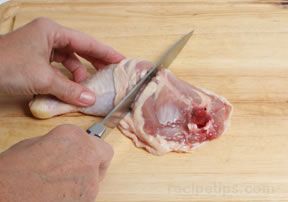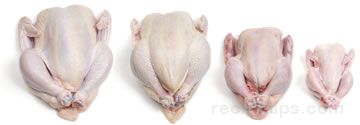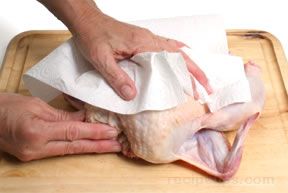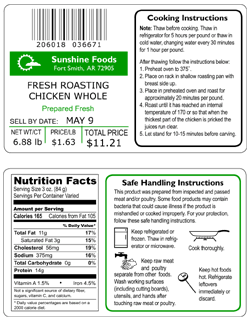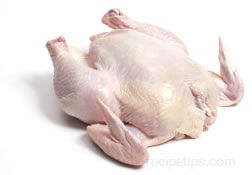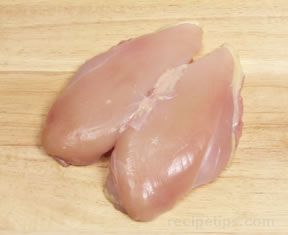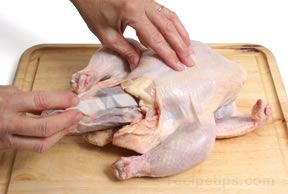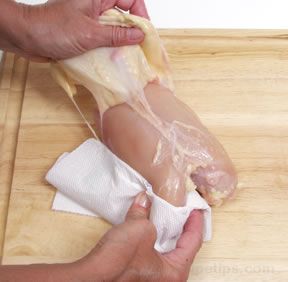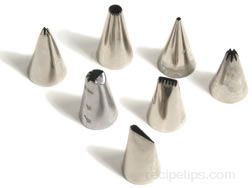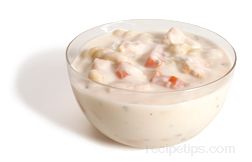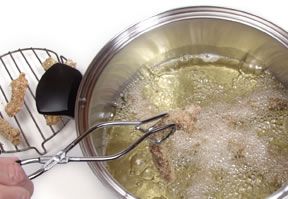|
Shopping Tips | Freezing Tips | Thawing Tips | Stuffing Tips | Checking Doneness Tips
Frying Tips | Grilling and Broiling Tips | Steaming Tips | Poaching Tips | Stir-fry Tips
Tenderness Tips | Light Tips | Cooking Tips
Shopping Tips:
- Read the package label to see what parts are contained in the package, a product description, the total weight, a sell-by date and nutritional information.
- The "sell-by" date is 7 to 10 days after the chicken was slaughtered and if properly refrigerated it should remain fresh 2 to 3 days after that date. If it is a "used-by" date, the chicken should be cooked or frozen by that date.
- Choose plump, moist chicken with skin that is not patchy or transparent in appearance.
- When choosing fresh chicken, avoid meat that show signs of freezing by feeling or looking for ice formation. When choosing frozen chicken, select one that is rock hard and shows no signs of freezer burn.
Freezing Tips:
- Use moisture proof wrap or bags when freezing chicken. Wax paper is not moisture proof and should not be used because it would not hold the moisture in the meat.
- Be sure all packages are marked with the content and the date the chicken was frozen.
- Wrapping individual chicken parts in foil or with freezer wrap and then placing in a freezer bag will allow you to take out only the number of pieces you will need.
- Freeze fresh chicken as soon as possible to maintain the best quality.
- Store frozen chicken in a freezer unit to obtain maximum storage time.
- Thaw frozen chicken using one of three methods: in the refrigerator; in a cold water bath, changing the water every 30 minutes; or in the microwave. NEVER thaw chicken at room temperature
Thawing Tips:
- Be sure the chicken, particularly a large whole bird, is defrosted thoroughly to ensure proper cooking. Place a hand inside the cavity of the chicken to check for ice crystals. If any crystals are present, more thawing time is needed.
- Thawed chicken should be cooked as soon as possible. If not using the chicken immediately, store in the refrigerator and use within 24 hours of thawing.
- Remove the giblets from the cavity of a whole chicken as soon as thawing allows.
- While the chicken is thawing, be sure drippings do not contaminate other food or preparation surfaces.
Stuffing Tips:
| Note: It is recommended that the stuffing be cooked outside of the chicken in a separate dish to reduce the risks of bacterial growth. |
If the stuffing will be cooked in the cavity of the chicken, follow these guidelines:
- Thoroughly rinse the chicken inside and outside before stuffing.
- Be sure stuffing is completely cooled before inserting into the cavity of the chicken.
- Do not overstuff the chicken, the stuffing will expand during cooking.
- The stuffing should reach an internal temperature of 165°F.
- Once the chicken and stuffing are done, remove the stuffing from the chicken immediately.
| Note: NEVER stuff the chicken in advance. Stuffing in advance will increase the risk of bacteria growth. Stuffing can be made in advance and refrigerated separately from the chicken and then inserted in the chicken just before cooking. |
Tips for Checking Doneness:
- When cooking a whole chicken, the skin should be golden brown and the legs should move easily in their joints.
- When pricked in the thigh or breast, the juices should run clear with no pinkish coloring. Tilting a whole bird up, so the juices from the cavity run out, should also show clear juices.
- To ensure doneness, check the temperature of the chicken with a meat thermometer. A thermometer inserted into the thickest part of the thigh or breast should produce a temperature of 170°F.
- When a slit is cut into the thickest part of the chicken, it should show meat that is opaque in appearance.
Tips for Frying Chicken:
- It is best to leave the skin on while cooking. If desired, remove before eating.
- When pan-frying, cover for the first 5 minutes of cooking and then uncover for the remainder of the cooking time. Covering for a short period of time will help cook the chicken thoroughly.
- Use tongs or a spatula instead of a fork when placing chicken pieces in the pan or when turning the pieces. Piercing the chicken with a fork allows the juices to escape.
- Be sure all utensils and equipment are dry before they come in contact with the oil. Water will make the oil splatter when heated.
- Using canola oil provides a milder taste, and it contains healthier amounts of saturated and polyunsaturated fats.
- Remove pieces of chicken from the oil as soon as they finish cooking. To keep the chicken warm while other pieces are cooking, set the pieces that are done on a baking pan covered with paper towels and place it in the oven at a low temperature.
- Do not cover the chicken once it has finished cooking, because covering will cause the coating to loose its crispness.
Grilling and Broiling Tips:
- To prevent dryness, leave the skin on the chicken during cooking, which helps preserves the chicken's natural moisture.
- Be sure racks are clean and coat them with vegetable oil or a nonstick vegetable oil spray to help prevent sticking.
- When grilling, aromatic woods, such as hickory, mesquite or cherry, can be added to the preheated coals to give the chicken a distinctive flavor.
- Place smaller pieces of chicken around the outer edges, further away from the main heat source, to allow them to cook slower.
- Do not use a fork to turn the chicken as it cooks. The piercing causes the juices to escape.
- To speed grilling or broiling time, partially cook the chicken in the microwave first. Microwave on high approximately 4 to 5 minutes per pound, or 3 to 4 minutes if using cut up parts. Grill or broil the microwaved pieces of chicken immediately to finish cooking.
Steaming Tips:
- Marinate the chicken before steaming to give the chicken a distinctive flavor.
- Impart flavor into the chicken by adding ingredients to the steaming water, such as onions, carrots, celery, and fresh gingerroot.
- Making a few cuts through the top and bottom surface of the chicken will allow the heat to penetrate more evenly throughout the cooking process.
- Other ingredients, such as vegetables, can be steamed with the chicken, but do not overcrowd.
- Avoid removing the cover to the pot during the cooking process. This will allow heat and steam to escape, resulting in extended cooking times.
Poaching Tips:
- For added flavor, season liquid with herbs, such as dried rosemary, sage, thyme, dill, or tarragon. Also, other flavorings, such as ginger, garlic and onion can be added.
- Rubbing the chicken with lemon juice and then poach in water containing lemon juice or white wine vinegar will help to keep the flesh of the chicken white when cooked.
- If the poached chicken is to be eaten cold or added to another dish, allow the meat to cool in the liquid to provide a moister texture. However, this procedure should be avoided in warm weather, because then the chicken should be cooled as quickly as possible and then refrigerated.
- After cutting the cooked chicken off the bones, return the bones to the liquid the chicken was cooked in and simmer longer to increase the flavor of the broth.
Stir-fry Tips:
- Cut ingredients into small even sized pieces. Using the same size pieces will assist in a more evenly quick cooking of all ingredients. For your convenience, you can purchase the vegetables precut for stir-frying but be prepared to pay more for them.
- To make the cutting of chicken into thin strips easier, place chicken in the freezer for about ¾ to 1 hour to firm it up or if the chicken was frozen, cut it into the thin strips before it is completely thawed.
- Use metal or wood utensils for stirring and tossing ingredients while cooking and avoid using plastic because it might melt when exposed to the high temperatures used for stir-frying.
- After cutting the chicken into thin strips, be sure to properly clean the work area. Wash the cutting boards in hot soapy water after each use and use a mild bleach solution periodically.
Tenderness Tips:
- Avoid freezing whenever possible to eliminate additional moisture loss during thawing, which results in less tender meat.
- Keep chicken from drying out in the refrigerator by keeping it tightly wrapped. If the chicken dries out, it will become tough.
- Leaving the skin on the chicken, when cooking it, helps to hold in juices, which increases tenderness.
- To keep breast area of chicken from drying out during roasting, place a piece of foil over this area. Remove during last 30 minutes of roasting time to allow the skin to brown properly.
- Cook chicken to the proper temperature, because undercooking the chicken will cause it to be tough and overcooking the chicken causes loss of moisture, making the chicken drier.
- Let roasted chicken rest for 10 to 15 minutes before carving to allow juices to be distributed throughout the meat. Standing the chicken up with bottom end up allows more juices to run into the drier breast area.
- Cutting meat across the grain will produce slices with shorter fibers, resulting in more tender pieces.
- When adding cooked chicken to dishes that have a long cooking time, it is best to use dark meat because it will stay moist longer than white meat.
Light Tips:
- Roasting chicken on a rack, broiling and grilling are cooking methods that allow fat to drip away from the meat. Poaching, steaming and microwaving are methods of cooking where no additional fat is used. All provide for less fat content in the meat when it is done.
- When frying or browning chicken in a pan, use a nonstick skillet, which requires less added fat, or use a nonstick skillet with a fat free nonstick cooking spray to reduce the amount of fat used.
- Reduce added fat by seasoning chicken in marinades that are low-fat or fat-free. Use ingredients such as low-fat yogurt, juices, wine, herbs, and spices
- Removing the skin before eating chicken eliminates about two thirds of the fat content.
- When stewing chicken for soup, let broth cool and then discard fat that forms on top before reheating to serve.
Cooking Tips:
- When adding chicken to a recipe that calls for a measured amount, determine how much chicken is needed by following a standard of one pound of boneless chicken equals approximately 3 cups of cubed chicken.
- When roasting a chicken, an untrussed chicken will cook faster and more evenly than a trussed chicken.
- Covered chicken takes longer to cook in the oven than uncovered chicken.
- When frying, grilling, broiling, or sautéing chicken, remove pieces as they get done to avoid overcooking while finishing other pieces. White meat and smaller pieces, such as breasts and wings, will get done faster than dark meat pieces, such as legs and thighs.
- For a quick test of doneness when roasting a chicken, hold on to the leg, move it around, and side to side. The leg should move freely at the joint if it is done. Be sure to use other methods for checking doneness also!
- Do not overcrowd chicken pieces when cooking. Leaving space between them will allow them to brown and cook more evenly.
- If using a marinade for basting, set some marinade aside before placing raw chicken in it to marinate. Never reuse marinade that the chicken was marinated in for basting.
- Be sure to use a sharp knife when cutting or carving chicken. Sharp knives will make the job a lot easier, especially when having to cut in the joint areas, and will provide neatly cut slices and pieces.
|


